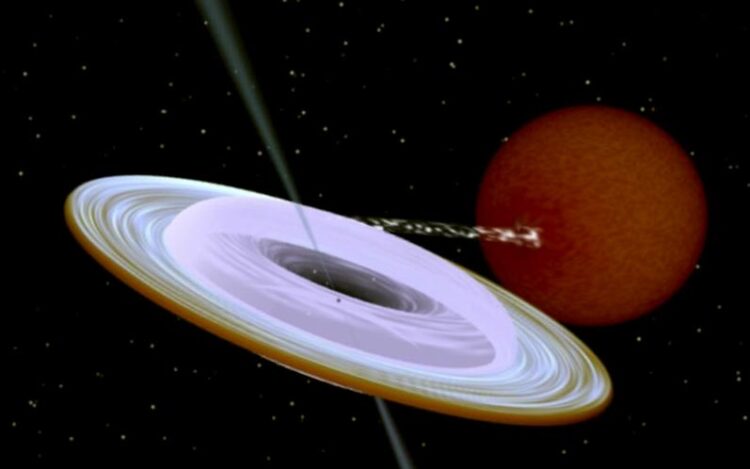Death spiral: a black hole spins on its side

Artist impression of the X-ray binary system MAXI J1820+070 containing a black hole and a companion star.
Grafic: R. Hynes
An international team of astronomers including those from the University of Freiburg and Leibniz Institute for Solar Physics (KIS), Germany, found that the axis of rotation of a black hole in a binary system is tilted more than 40 degrees relative to the axis of the stellar orbit. The finding challenges current theoretical models of black hole formation. The study has been published in “Science”.
Astronomers made the first reliable measurement of a large difference between the axis of rotation of the black hole and the axis of the binary system orbit. The difference between the axes measured by the researchers in a binary star system called MAXI J1820+070 was more than 40 degrees.
Often for the space systems with smaller objects orbiting around the central massive body, the own rotation axis of this body is to a high degree aligned with the orbital axis of its satellites. This is true also for our solar system: the planets orbit around the Sun in a plane, which roughly coincides with the equatorial plane of the Sun. The inclination of the Sun rotation axis with respect to the orbital axis of the Earth is only seven degrees.
“The expectation of alignment, to a large degree, does not hold for the bizarre objects such as black hole X-ray binaries. The black holes in these systems were formed as a result of a cosmic cataclysm − collapse of a massive star. Now we see the black hole dragging matter from the nearby, lighter companion star orbiting the system’s gravity center. We see bright optical and X-ray radiation as the last sigh of the infalling material, and also radio emission from the relativistic jets expelled from the system.” – says Juri Poutanen, Professor of Astronomy at the University of Turku (UTU), Finland, and the lead author of the publication.
By following these jets in radio and the X-rays, the researchers were able to determine the direction of the axis of rotation of the black hole very accurately. As the amount of gas falling from the companion star to the black hole later began to decrease, the system dimmed, and much of the light in the system came from the companion star. In this way, the researchers were able to measure the orbit inclination using spectroscopic techniques, and it happened to nearly coincide with the inclination of the ejections. The 3D orientation of the orbit in space was determined by a critical measurement of the positional angle of the system on the sky (with respect to the direction to the North) using the polarimetric technique.
“The high-precision polarimetric instruments and techniques developed at KIS jointly with UTU reveal novel information about the geometry and physics of exoplanets, asteroids, interstellar magnetic field, white dwarfs and now black holes, because light waves become polarized by scattering and magnetic fields. Our polarimeter DIPol-UF used in this study is unique in its capacity to measure optical polarization with the precision and accuracy of a few parts per million. Determining the orbit orientation of black holes using polarization opens a new path towards understanding their formation and physics.” – says Prof. Dr. Svetlana Berdyugina of the University of Freiburg who leads high-precision polarimetry projects at KIS is a co-author on the paper.
The found difference of more than 40 degrees between the orbital axis and the black hole spin was completely unexpected. Scientists have often assumed this difference to be very small when they modeled the behavior of matter in a curved time space around a black hole. The new finding forces scientists to add a new dimension to the models.
The results are published in Science magazine and provide new insights into black hole formation and evolution of such systems, as such extreme misalignment is hard to get in many black hole formation and binary evolution scenarios.
The key finding was made using the polarimetric instrument DIPol-UF, built jointly by the Leibniz Institute for Solar Physics (KIS) and the University of Turku and deployed at the Nordic Optical Telescope, which is owned by the University of Turku jointly with the Aarhus University in Denmark. The funding for the instrument was provided by the ERC Advanced Grant HotMol led by Prof. Dr. Berdyugina.
Information to the attached iIllustration:
Artist impression of the X-ray binary system MAXI J1820+070 containing a black hole (small black dot at the center of the gaseous disk) and a companion star (red). A narrow jet is directed along the black hole spin axis, which is strongly misaligned from the axis of the orbit. Image produced with Binsim (credit: R. Hynes).
Wissenschaftliche Ansprechpartner:
Prof. Dr. Svetlana Berdyugina, Email: svetlana.berdyugina@leibniz-kis.de
Originalpublikation:
The research paper was published in Science
https://doi.org/10.1126/science.abl4679
Media Contact
All latest news from the category: Physics and Astronomy
This area deals with the fundamental laws and building blocks of nature and how they interact, the properties and the behavior of matter, and research into space and time and their structures.
innovations-report provides in-depth reports and articles on subjects such as astrophysics, laser technologies, nuclear, quantum, particle and solid-state physics, nanotechnologies, planetary research and findings (Mars, Venus) and developments related to the Hubble Telescope.
Newest articles

A universal framework for spatial biology
SpatialData is a freely accessible tool to unify and integrate data from different omics technologies accounting for spatial information, which can provide holistic insights into health and disease. Biological processes…

How complex biological processes arise
A $20 million grant from the U.S. National Science Foundation (NSF) will support the establishment and operation of the National Synthesis Center for Emergence in the Molecular and Cellular Sciences (NCEMS) at…

Airborne single-photon lidar system achieves high-resolution 3D imaging
Compact, low-power system opens doors for photon-efficient drone and satellite-based environmental monitoring and mapping. Researchers have developed a compact and lightweight single-photon airborne lidar system that can acquire high-resolution 3D…





















